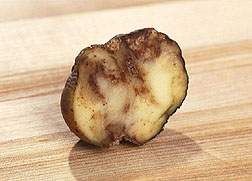This page has been archived and is being provided for reference purposes only. The page is no longer being updated, and therefore, links on the page may be invalid.
ARS Scientists Help Sequence Genome of Potato Late Blight Pathogen
By Stephanie YaoSeptember 9, 2009
The complete genome of the pathogen that caused the infamous Irish potato famine and the recent loss of potato and tomato crops in the eastern United States has been sequenced by Agricultural Research Service (ARS) scientists and cooperators.
Phytophthora infestans is a fungus that causes the disease commonly known as late blight, the most destructive disease of potato. It can also infect tomatoes and other members of the Solanaceae family. Once the pathogen attacks, there is little a commercial grower or home gardener can do to save the crop, which can be completely destroyed in just one week. Additionally, the pathogen's ability to quickly mutate and develop resistance to current fungicides makes it difficult to control.
ARS plant pathologist Richard Jones, with the agency's Genetic Improvement of Fruits and Vegetables Laboratory in Beltsville, Md., led a group responsible for examining and annotating the genes that produce enzymes to degrade a plant's cell wall. Former postdoctoral researchers Stefano Costanzo, now a plant pathologist at the ARS Dale Bumpers National Rice Research Center in Stuttgart, Ark., and Manuel Ospina-Giraldo, now on the faculty of Lafayette College in Easton, Pa., contributed to this research. Ospina-Giraldo also conducted a significant amount of this research while with Lafayette College.
Jones and colleagues found several groups of enzymes located close to each other on the genome of P. infestans. The pathogen secretes these enzymes to attack the surface of the plant, allowing it to break through and begin feeding on the plant's nutrients. The scientists believe two of these enzyme groups may be used by the pathogen at the initial stage of infection.
The researchers were also the first to identify and report a unique pattern of gene segments called introns in the pathogen's genome that give the pathogen the ability to produce different proteins from the same gene and attack different compounds within the plant cell wall. This may further explain how the late blight pathogen is so successful in attacking plants, according to Jones.
This research is published in the scientific journal Nature.
ARS is the principal intramural scientific research agency of the U.S. Department of Agriculture.


